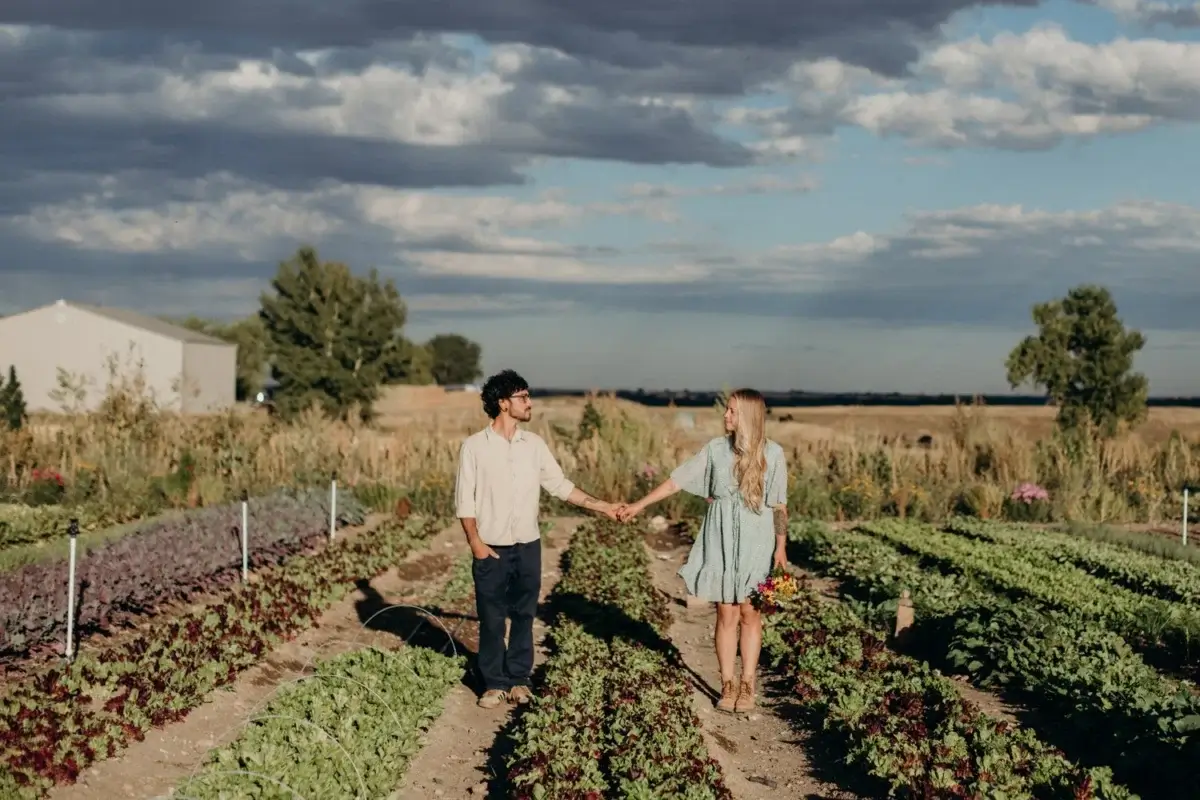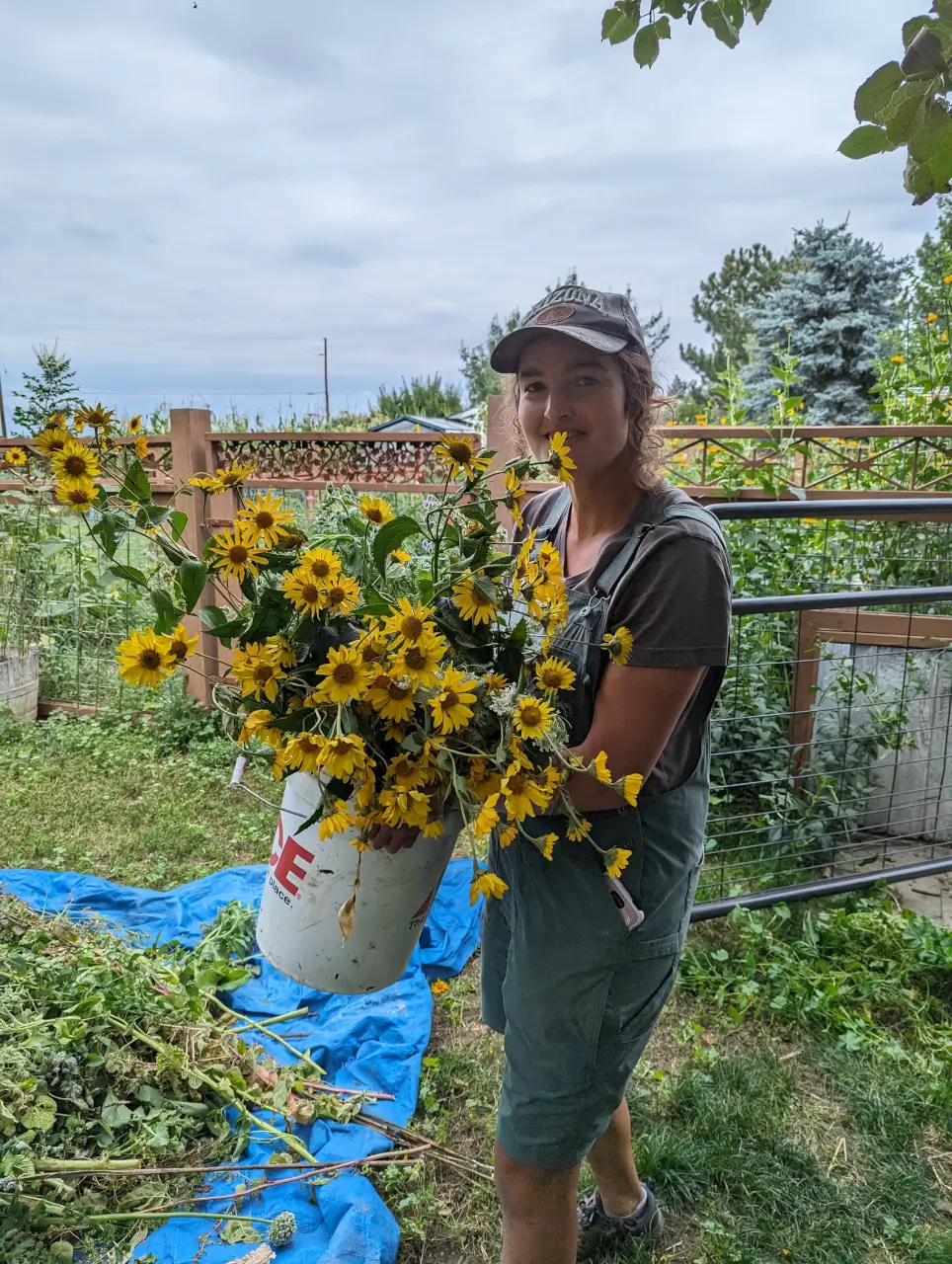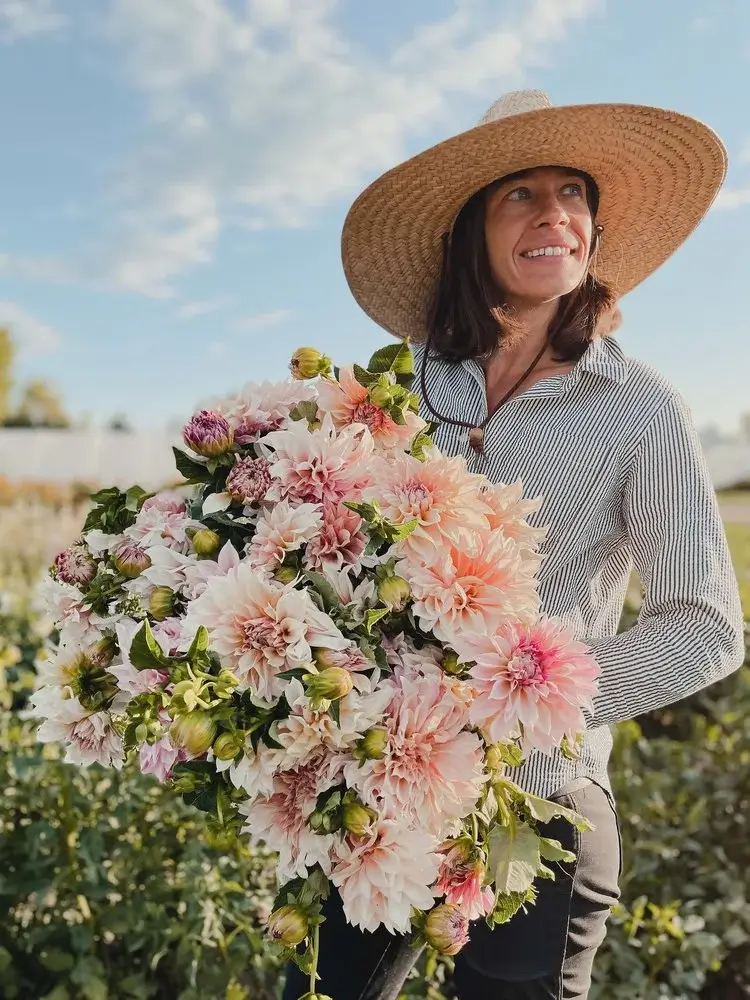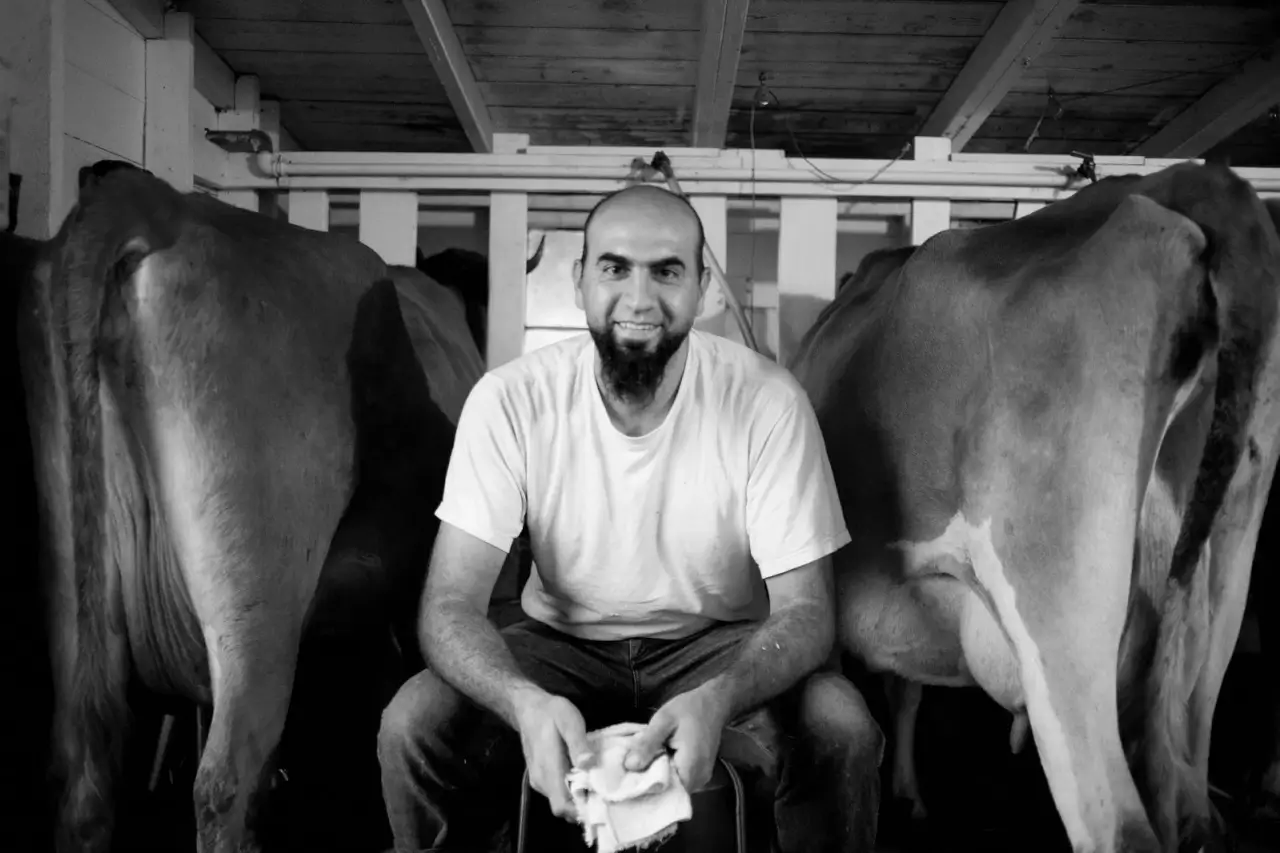How the Next Generation of Farmers is Getting Creative with Land Access
From collectives, to backyard farms, to leasing public land, the way we farm is shifting.
How the Next Generation of Farmers is Getting Creative with Land Access
From collectives, to backyard farms, to leasing public land, the way we farm is shifting.

Cody Jurbala and Melissa Ogilvie run Speedwell Farm. In 2020 they formed a collective with another small farm to lease land.courtesy of Speedwell Farms
Check out our companion piece: How to Start a Backyard or Urban Farm—Whether You Own Land or Not
As a renter millennial, I wanted to start farming. But as Charlotte says in Pride and Prejudice, “I’ve no money and no prospects.” This is a common sentiment among many student-loan-saddled millennials and Gen Z-ers who want to work with the land but don’t have land that they own to start gardening or farming.
It’s no secret that the agricultural industry is facing multiple converging challenges including an urgently looming generational shift. According to the 2022 USDA Census of Agriculture, the average age of a farmer is 58, with organic farmers coming in slightly younger at 52. Only 8 percent of the United States’ 3.3 million farmers are under the age of 35, whereas 14 percent are over the age of 75.
What happens when they retire?
The other confounding factor is that many young people do not have the financial capital to buy a farm outright. Seventy-two percent of millennials, most in their 30s and early 40s, have non-mortgage debt averaging $117,000.
Maybe a better question is: How can the next generation afford to farm?
I was able to find a family on Nextdoor who wanted their backyard to be used, and I now have a mini flower farm in Boulder, Colorado there. It turns out my experience is becoming an increasingly common way to start getting your footing as a young or beginning farmer. I spoke to several first-generation farmers based in Denver and Boulder, Colorado who all had different approaches.
Relationship-Based Land Stewardship
Amy Scanes-Wolfe runs the 1.4-acre Niwot Homestead in a suburban yard that belongs to a family she found through Nextdoor. “We have never written an agreement or signed documents; no money has ever changed hands,” says Scanes-Wolfe. “We truly have been doing this in a relational way.” The Homestead grows vegetables, herbs, grains, and animals such as ducks, pigs, and chickens. Any farm expenses such as seedlings and irrigation setup are paid for by Scanes-Wolfe, but infrastructure investments that add to property value are paid for by the homeowners.

Scanes-Wolfe volunteered and worked on farms for several years before posting on Nextdoor and connecting with the landowners. She started small, getting to know the family and just growing a personal vegetable garden. “They wanted the property used, but [they] didn’t have a strong driving vision,” says Scanes-Wolfe. She has been able to take the lead on the vision and growth of the farm. Whenever issues arise, such as the roaming habits of free-range chickens, they all sit down “as humans” to talk them through and come to a solution together. Now, four years later, the Niwot Homestead bloomed from a vegetable garden to a permaculture-inspired and volunteer-run farm, complete with vegetables, perennials, fruit trees, pigs, and chickens.
Scanes-Wolfe says these types of relational agreements must be centered in mutual respect—for everyone involved and the space itself. However, some people may want a more formal structure. For my own backyard farm, I have a contract with the homeowners that outlines which spaces I can use, who covers expenses, what protections are in place for liability, and other pertinent details.
Speedwell Farm & Gardens started growing in neighbors’ backyards in Boulder as well. It had contracts in place, and it would pay homeowners for city water use by comparing bills to previous years. Backyard farms may need infrastructure for things ranging from drip lines and irrigation systems to hoop houses or greenhouses. Be sure to discuss any infrastructure needs before starting, and be clear on whether you (the farmer) or the homeowner is responsible for costs and installation.
Investing in Real Estate as a Means to Farm
Jamie and Doug Wickler were engineers, but the 2008 crash made them reconsider career paths. For a few seasons, Jamie Wickler worked at Denver Botanic Gardens farm. “I had aspirations of farming and knew I wanted it to be a family thing; I just wasn’t sure how,” she says , noting that most of the farms she saw had a million dollars of debt or unstable land leases.

Coincidentally, the Wicklers decided to invest in a rental property as a retirement plan. They had bought their home in 2013, and they secured their first rental property in 2017 (when real estate was more affordable) with help from family and friends. Then came the aha moment—tenants wouldn’t want to maintain a yard, and the Wicklers wanted to farm.
Wild Wick’s Farm was born, turning the yards at their own home and rentals into a diverse urban farm that grows more than 70 varieties of vegetables and cut flowers. They worked with banks to get a second rental property in 2018 and a third in 2020—all within a mile of each other.
Tenants agree to not use any pesticides and allow the Wicklers access to the yard. “Most of the tenants really like that we maintain the properties,” says Wickler. “They see it as an eco model that is very interesting.” Plus, having multiple plots is great for their farm management strategy as they rotate crops seasonally to reduce pest pressure and replenish soil nutrients.
When the Wicklers bought their properties in 2017-2020, real estate was significantly cheaper. Now, real estate prices have risen drastically, so Wickler’s advice for future farmers is to think outside the box. “With different industries that do make money,” she says, “how can it blend with land to make it more lucrative to farm?”
Leasing Farmland as a Collective
In Longmont, Colorado, Helen Skiba and Nelson Esseveld run Artemis Flower Farm, while Cody Jurbala and Melissa Ogilvie run Speedwell Farm & Gardens. In 2020, the two farms came together to form the Treehouse Farm Collective, a separate LLC that enabled them to put forward a strong proposal for a farmland lease and get approved. Luckily, they complimented each other—flowers and vegetables —and both farms had existing customer bases.

Skiba started farming in the Peace Corps, coming back and working a small local farm in Colorado where she was introduced to growing and designing with flowers. She moved on to manage a two-acre cut flower parcel at a large market farm for a couple of years.
Jurbala fell in love with vegetables through cooking, interning at a local farm in 2014, then taking an online urban farming course. That’s where he learned “that land access was the hardest part of somebody starting the farming journey,” and where he realized people’s unmaintained yards were the easiest access point. He used Google maps to scope, cold-called people and eventually found three yards in the same neighborhood to start farming with very little overhead.
However, both farms were on the hunt for a more permanent situation in 2020. “I knew I was going to continue farming, it was just a question of land access,” says Skiba. “So, what can I do? Can me and my husband buy land or afford land?”
After looking at several properties that didn’t work out, she came across a gem of a lease that had everything a farmer would need to get started on the right foot—17 acres with six suitable for farming, a greenhouse, and irrigation pond. But she needed a stronger proposal than just her farm could support. A mutual friend connected her to Jurbala, and the Treehouse Collective was born. Together, they were approved for the lease.
The collective houses their two farms, and they sublease portions of the property to other businesses, currently a vermicompost venture (creating high-quality compost with worm castings) and a tool library for local farmers.
They contribute their success to aligned land management philosophies and great communication. Monthly meetings allow for problem solving, but day-to-day conversations keep it harmonious.
Jurbala highlights that the collective model is great for young farmers. “If you can take away some of the financial burden upfront and have community, that’s a big thing,” he says.
Ranching on Public Lands
André Houssney runs Jacob Springs Farm, a regenerative ranch that produces dairy, beef, lamb, pork, chickens, and wheat in East Boulder. Houssney came to the US as a refugee from the Middle East at age nine, growing up in Boulder and working on his neighbor’s farm.

After college, Houssney worked for nonprofits and started successful agricultural businesses supporting farmers in Africa. When he returned to Colorado, he was able to buy six starter acres, but he knew Boulder offered a unique opportunity—the city leases public Open Space land (undeveloped natural areas) to farmers and were looking for the next generation. He steadily grew his business and leased 800 private mountainous acres to graze dry cattle that don’t produce milk. For years, he applied for Open Space leases.
“It wasn’t adding up,” he says, explaining that after each losing bid, he’d ask how to improve and get contradictory advice. “They continued to give land to the big guys, the old guys, the white guys,” he says, “even though I had the style of regenerative farming that they said they wanted.”
When asked, Boulder County officials say they do not collect ethnicity or gender data in their proposals, but a representative did say that “a majority of our tenants are what you would likely consider your typical white and male farmer/rancher for the region.”
After years of rejections, Houssney appealed the decision citing inconsistencies in scoring. It was reversed, and he was selected for a 170-acre parcel with a milking parlor—a crucial element for his business to thrive. That was four years ago, but his struggle with bureaucracy is ongoing.

Houssney’s story is not unique. Farmers of color and land stewards have been subject to discriminatory practices and land dispossession since this country’s inception, and it’s never stopped. In 1920, Black farmers owned 14 percent of US farms, but now, they own only one percent, as the number of Black farmers decreased by 98 percent over the past century. This is largely due to Jim Crow-era policy, the exploitation of heir’s property, which is passed down generationally without wills or titles, and the USDA’s discriminatory lending practices, which harmed BIPOC and women farmers, spurring massive land loss.
If you’re interested in ranching on public lands, reach out to your city or county to see if they offer public land leases for agriculture. Ranching on public lands is common throughout the West, with the Bureau of Land Management administering 18,000 permits for ranchers to graze on public land, although it is less common to have a city or county lease land. Apply for a BLM lease if you’re in a state with a large amount of federally owned land.
Follow us
This work is licensed under a Creative Commons Attribution-NoDerivatives 4.0 International License.
Want to republish a Modern Farmer story?
We are happy for Modern Farmer stories to be shared, and encourage you to republish our articles for your audience. When doing so, we ask that you follow these guidelines:
Please credit us and our writers
For the author byline, please use “Author Name, Modern Farmer.” At the top of our stories, if on the web, please include this text and link: “This story was originally published by Modern Farmer.”
Please make sure to include a link back to either our home page or the article URL.
At the bottom of the story, please include the following text:
“Modern Farmer is a nonprofit initiative dedicated to raising awareness and catalyzing action at the intersection of food, agriculture, and society. Read more at <link>Modern Farmer</link>.”
Use our widget
We’d like to be able to track our stories, so we ask that if you republish our content, you do so using our widget (located on the left hand side of the article). The HTML code has a built-in tracker that tells us the data and domain where the story was published, as well as view counts.
Check the image requirements
It’s your responsibility to confirm you're licensed to republish images in our articles. Some images, such as those from commercial providers, don't allow their images to be republished without permission or payment. Copyright terms are generally listed in the image caption and attribution. You are welcome to omit our images or substitute with your own. Charts and interactive graphics follow the same rules.
Don’t change too much. Or, ask us first.
Articles must be republished in their entirety. It’s okay to change references to time (“today” to “yesterday”) or location (“Iowa City, IA” to “here”). But please keep everything else the same.
If you feel strongly that a more material edit needs to be made, get in touch with us at [email protected]. We’re happy to discuss it with the original author, but we must have prior approval for changes before publication.
Special cases
Extracts. You may run the first few lines or paragraphs of the article and then say: “Read the full article at Modern Farmer” with a link back to the original article.
Quotes. You may quote authors provided you include a link back to the article URL.
Translations. These require writer approval. To inquire about translation of a Modern Farmer article, contact us at [email protected]
Signed consent / copyright release forms. These are not required, provided you are following these guidelines.
Print. Articles can be republished in print under these same rules, with the exception that you do not need to include the links.
Tag us
When sharing the story on social media, please tag us using the following: - Twitter (@ModFarm) - Facebook (@ModernFarmerMedia) - Instagram (@modfarm)
Use our content respectfully
Modern Farmer is a nonprofit and as such we share our content for free and in good faith in order to reach new audiences. Respectfully,
No selling ads against our stories. It’s okay to put our stories on pages with ads.
Don’t republish our material wholesale, or automatically; you need to select stories to be republished individually.
You have no rights to sell, license, syndicate, or otherwise represent yourself as the authorized owner of our material to any third parties. This means that you cannot actively publish or submit our work for syndication to third party platforms or apps like Apple News or Google News. We understand that publishers cannot fully control when certain third parties automatically summarize or crawl content from publishers’ own sites.
Keep in touch
We want to hear from you if you love Modern Farmer content, have a collaboration idea, or anything else to share. As a nonprofit outlet, we work in service of our community and are always open to comments, feedback, and ideas. Contact us at [email protected].by Lindsey Beatrice, Modern Farmer
August 1, 2024
Modern Farmer Weekly
Solutions Hub
Innovations, ideas and inspiration. Actionable solutions for a resilient food system.
ExploreExplore other topics
Share With Us
We want to hear from Modern Farmer readers who have thoughtful commentary, actionable solutions, or helpful ideas to share.
SubmitNecessary cookies are absolutely essential for the website to function properly. This category only includes cookies that ensures basic functionalities and security features of the website. These cookies do not store any personal information.
Any cookies that may not be particularly necessary for the website to function and are used specifically to collect user personal data via analytics, ads, other embedded contents are termed as non-necessary cookies.
Love seeing how innovative young farmers and finding new ways to access land! It’s inspiring to see the blend of creativity and resilience in overcoming traditional barriers. The future of farming looks bright!